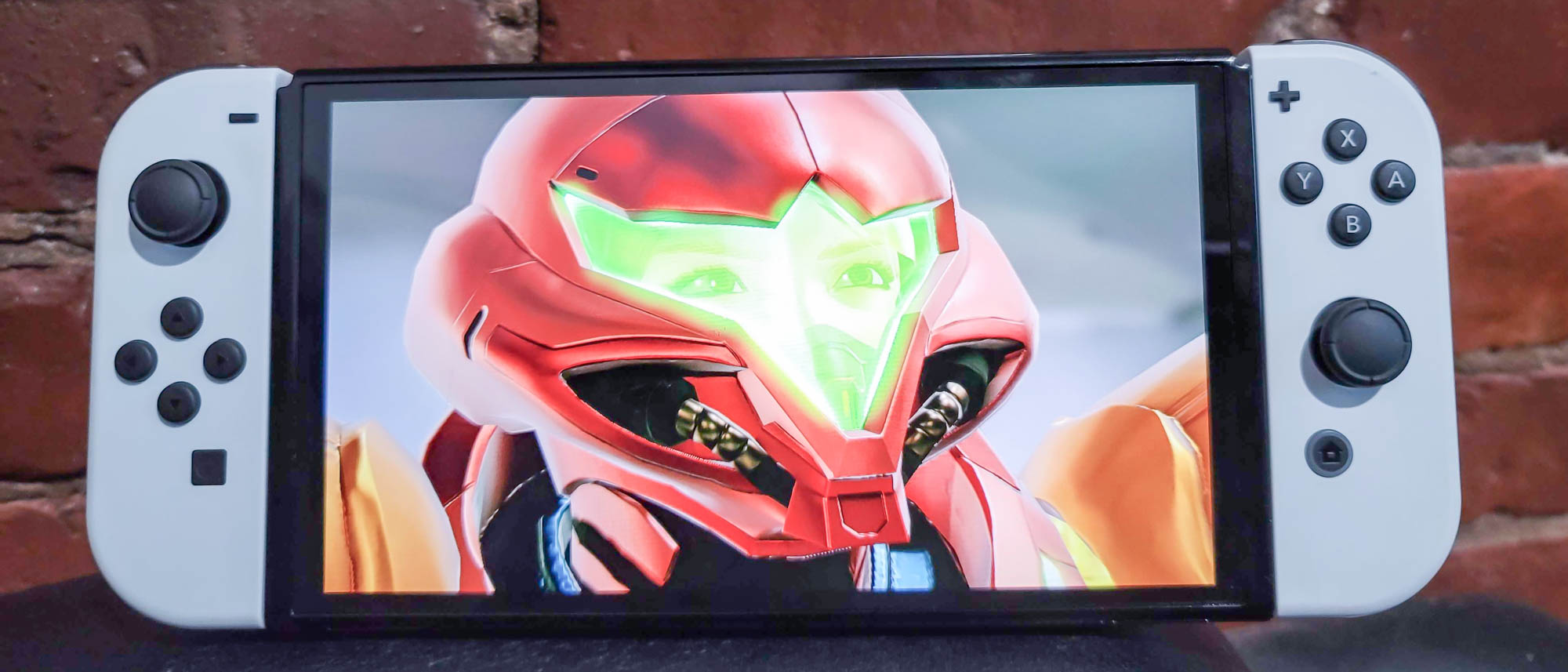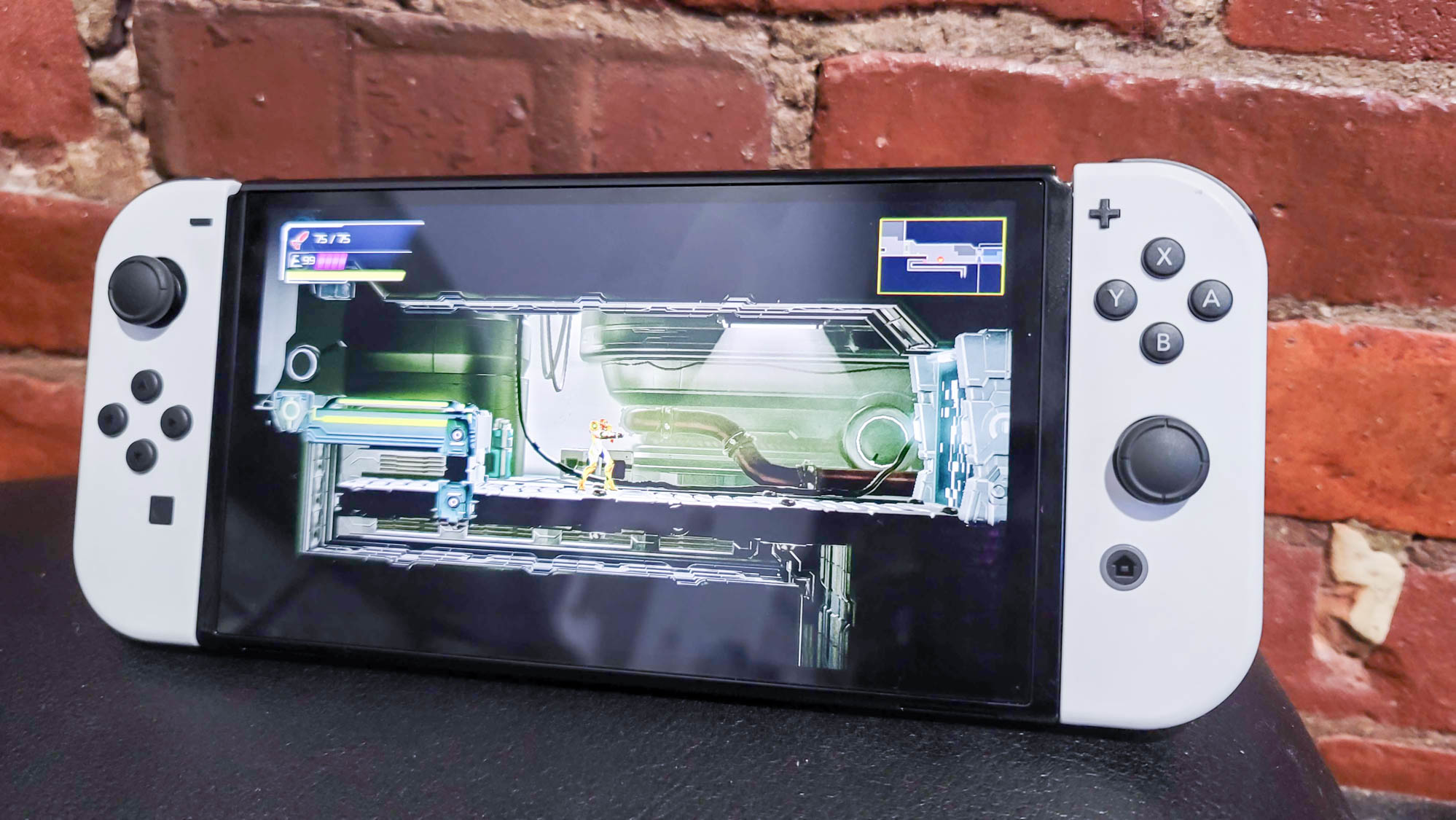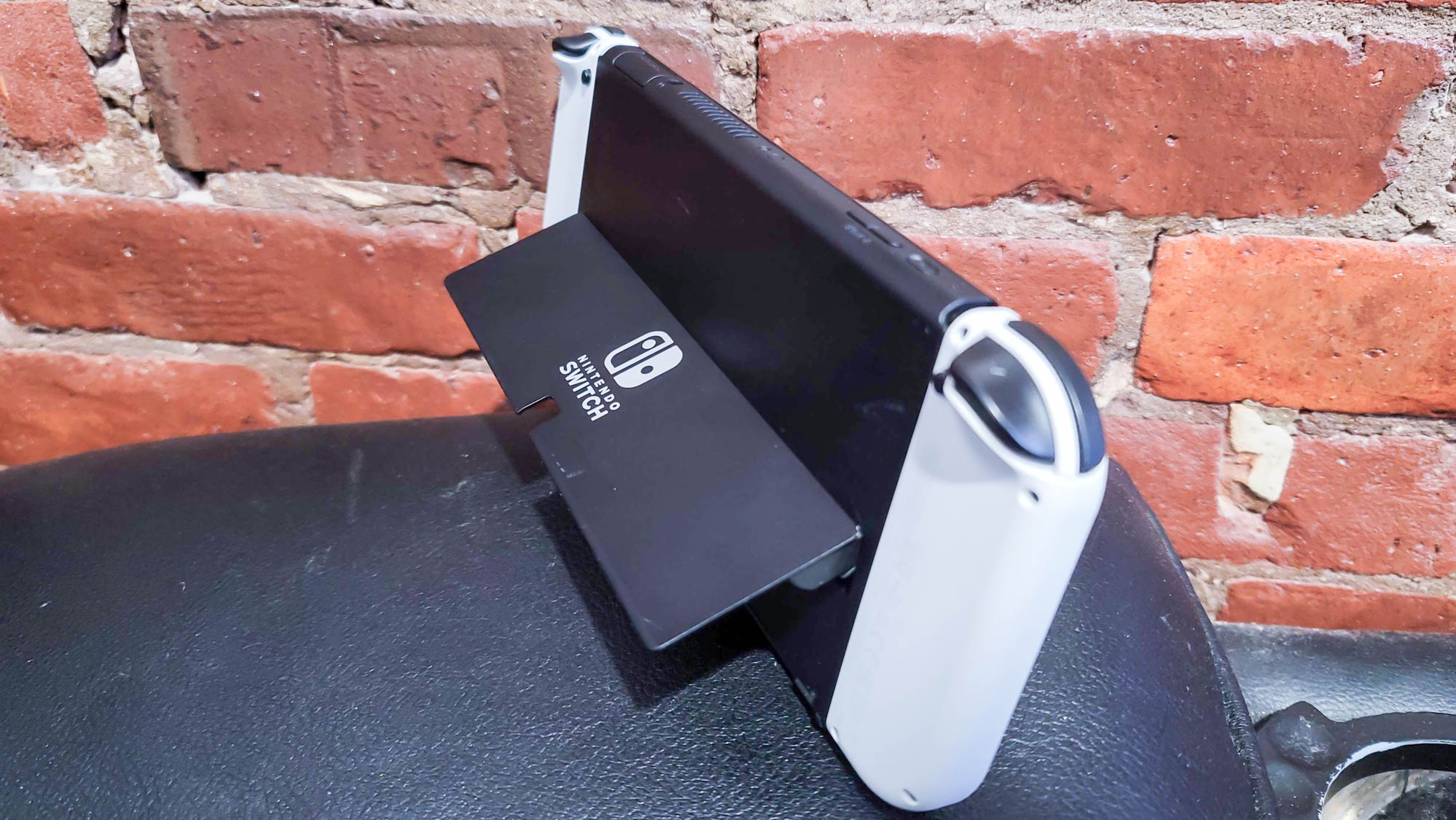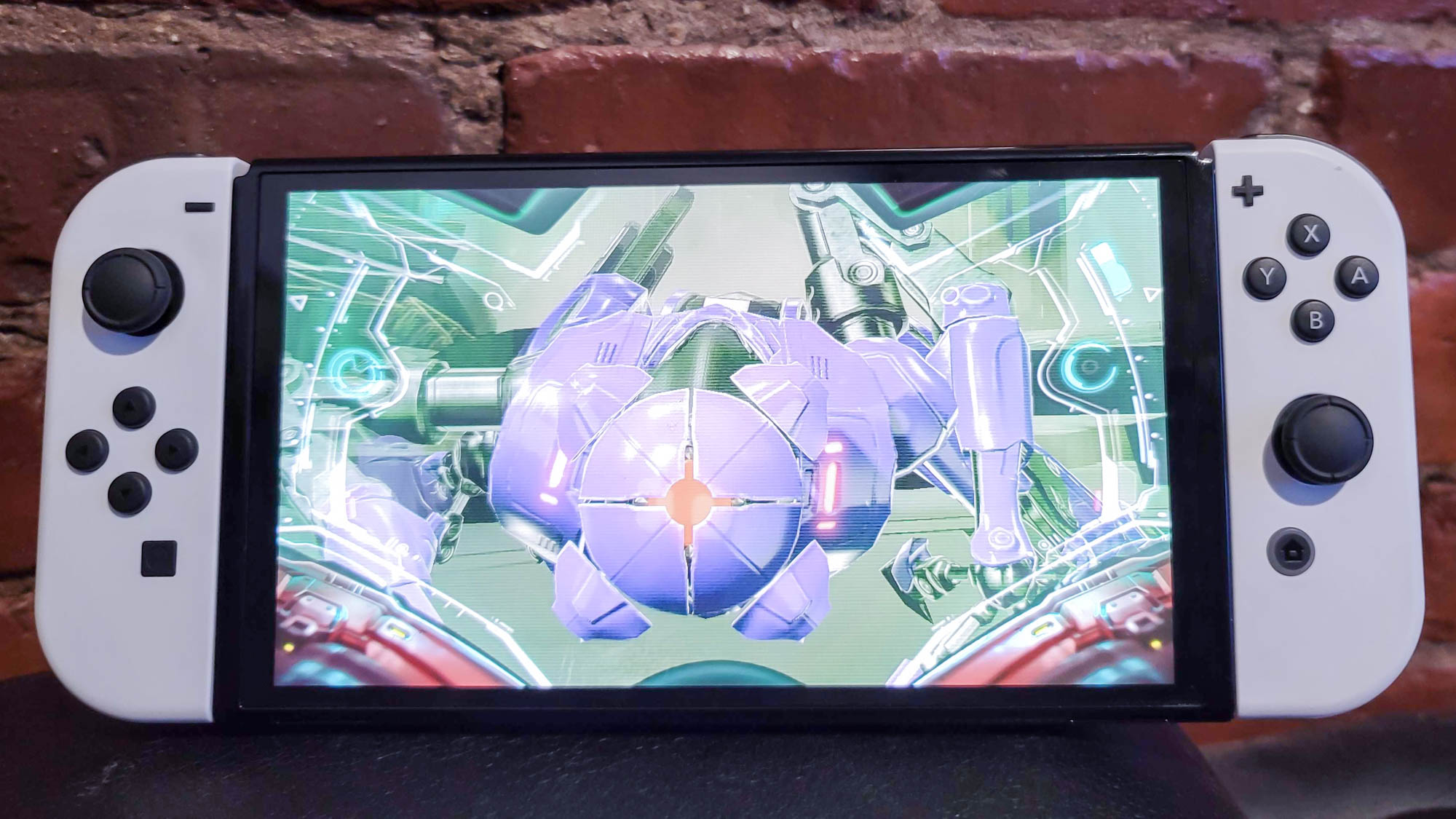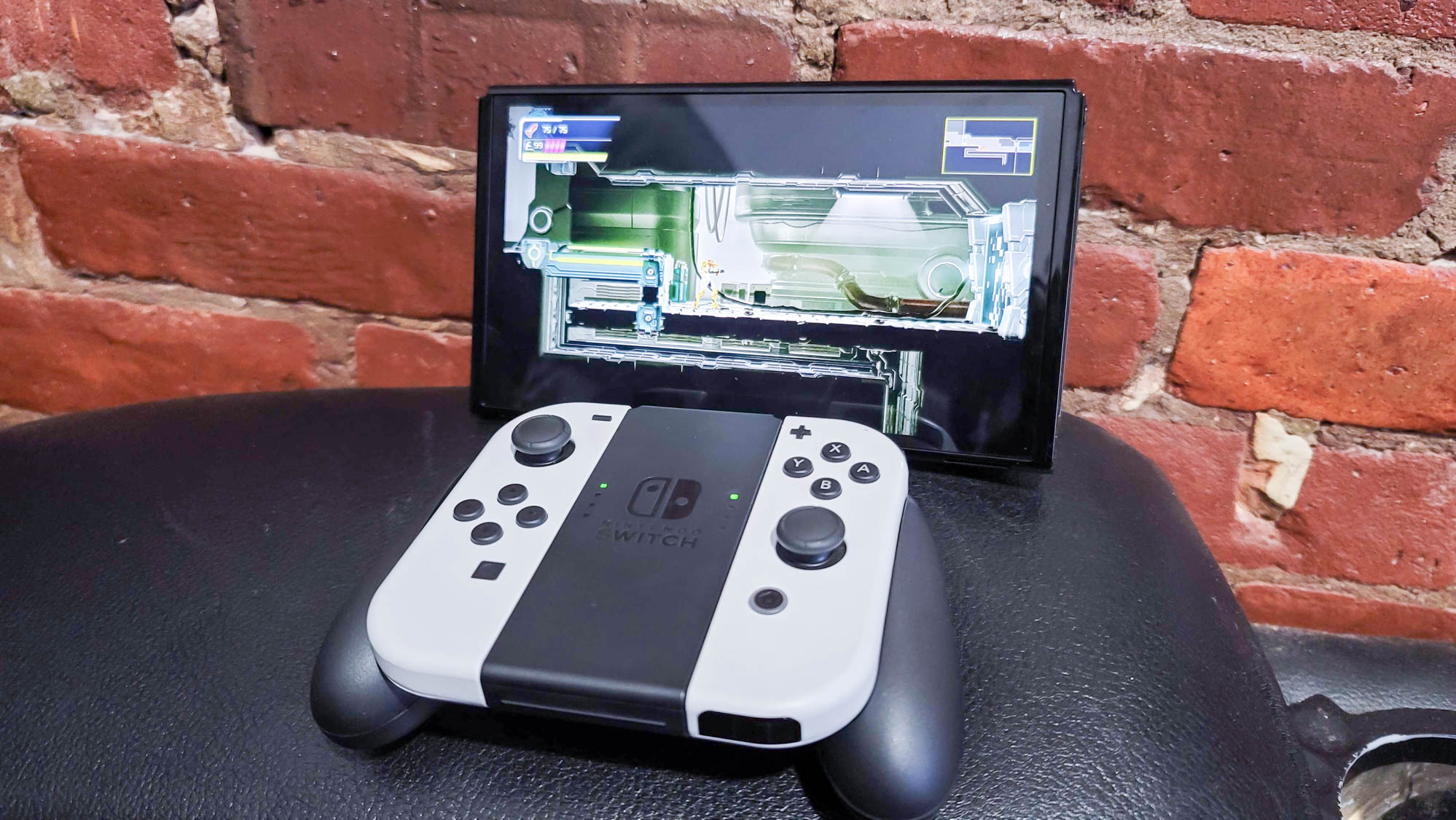Laptop Mag Verdict
The Nintendo Switch OLED brings a big beautiful screen, enhanced audio and an improved kickstand, but many of the OG Switch's features remain.
Pros
- +
Stunning new color scheme
- +
Gorgeous OLED display
- +
Robust game library
- +
Powerful speakers
Cons
- -
Lacks 4K ability
- -
Screen has a 720p resolution
- -
Seems a bit sluggish compared to next gen consoles
Why you can trust Laptop Mag
Price: $349
CPU: Nvidia Custom Tegra
GPU: Nvidia Custom Tegra
Storage: 64GB
Display: 7-inch, 1280 x 720
Battery: 4.5 - 9 hours (estimated)
Size: 4 x 9.5 x 0.55 inches
Weight: 14.9 ounces
After months of speculation, hopes and dreams, the Nintendo Switch OLED is here and while it lives up to hype in some aspects, it falls short in others. As the name suggests, the display is indeed OLED and it is bigger and prettier than its predecessor. Plus, you get more powerful speakers and possibly an end to the Joy-Con drift. And you get a new color scheme. However, for $349, it lacks any 4K capabilities. And despite the OLED panel, the resolution is still stuck at the same 1280 x 720. Still, for many Nintendo fans, the Switch OLED is the way to go.
Nintendo Switch OLED pricing and availability
Whether it’s a phone, laptop, TV or console, OLED doesn’t come cheap. The Nintendo Switch OLED costs a pretty penny at $349, making it the new top dog of the Switch lineup. It’s notably more expensive than the Xbox Series S and the original Switch which cost $299. However, it’s nowhere near as costly as either the PlayStation 5 ($399 digital, $499 standard) or the Xbox Series X ($499).
Nintendo Switch OLED design
As much as I liked the whimsical Neon Blue and the Neon Red Joy-Cons on the OG Switch, the Model White controllers on the OLED version make me feel really mature. Like I’m a grown-up, put-together adult who still loves to game. The Joy-Cons’ housing is made of a matte off-white plastic that’s smooth to the touch.
They’re about the same size as the original Joy-Cons and I had no problem mixing and matching the controllers between the two consoles. The Joy-Cons slide on and off the console with ease when you press the button along the back.
Now for the console itself. The front of the device is almost all display with a glossy plastic bezel bordering the 7-inch screen. Along the top of the panel you’ll find buttons for power and volume along with a card slot for the game cartridges and a headset jack. There’s also a large vent to help keep everything cool. On the bottom, you have a USB-C port and a pair of surprisingly powerful speakers (more on that later).
The back of the console is made of black matte plastic with a gray Nintendo Switch logo stamped on the kickstand. And oh, this kickstand! Instead of that little stubby thing I was always worried about snapping off (It never did, but it’s a concern that still sits in the back of mind), Nintendo gifted gamers with something a lot more substantial. The kickstand almost runs the full length of the console and flips halfway up the system, allowing for a really comfortable viewing angle. The pair of hinges are a bit stiff for my tastes, but otherwise, it’s a solid addition to the system. And when you raise the kickstand up slightly, you’ll see the microSD slot peaking out waiting for you to expand the storage from 64GB.
So in terms of size, the Switch OLED is just a tad bigger measuring 4 x 9.5 x 0.55 inches and weighs 14.9 ounces with Joy-Cons attached and 11.7 ounces without. The original Switch’s dimensions are 4 x 9.4 x 0.55 inches, 14.1 ounces with Joy-Cons, 10.6 ounces without the controllers.
Sign up to receive The Snapshot, a free special dispatch from Laptop Mag, in your inbox.
Nintendo Switch OLED display
Seven inches might not seem like much in the grand scheme of things, especially when compared to a 6.2-inch screen. But let me tell you, side-by-side, the difference is clear. Nintendo wisely cut down on the bezels for the Switch OLED, which makes the OG Switch’s panel seem diminutive by comparison. The Switch OLED’s screen is big enough to draw in the jealous oohs and ahhs without being cumbersome.
Bigger is definitely better in most cases, the real reason we’re here is in the product name - OLED. And man, organic light-emitting diode (OLED) is where it’s at. I love it on my smartphones and I love it on my laptops and TVs. Why wouldn’t I love it on my handheld console? This baby literally turned heads when I whipped it out in the Laptop office and I basked in all the attention. I made sure that Metroid: Dread, a pretty colorful game, was playing as I “worked” on my review. Intergalactic bounty hunter Samus Aran’s power suit looked absolutely resplendent as I made my way through the game. The orange-red and white suit never failed to draw my eye, especially when light gleamed off the golden accents lining strategic points of the suit.
And while it was a pesky foe, I couldn’t help but admire the deep-etched lines and weathered points of the Shakernaut robot as its large red sensor powered up to deliver a devastating laser blast my way. Both the color and the sharpness were noticeably different on the OG Switch, even though I was playing the same title and both screens have 1280 x 720 resolution.
Nintendo Switch OLED audio
The speakers on the old Switch were okay in a pinch, but they definitely had me reaching for a pair of headphones sooner than later. The enhanced speakers on the Switch OLED however, are a different matter. Will it fill up a smallish room with audio? No, but it definitely blew out the original’s Switch’s performance.
The herky-jerky metallic movements of the Shakernaut were more defined on the Switch OLED than on the original. And the delicious noise of and E.M.M.I.’s menacing robotic head being detached from its loathsome body sounded so much more gratifying on the Switch OLED.
Nintendo Switch OLED Joy-Cons
Buttons and analog sticks are still the same on the OLED and made of black plastic. The left analog stick is mounted in the top-left corner diagonally positioned from the - button, directly below the four directional buttons with the capture button rounding everything out. Along the top of the controller sits a left shoulder and trigger button.
On the right Joy-Con sits the + button in the top right, resting slightly above the four face buttons. The right analog stick resides directly below with the Home button just under that. Along the bottom of the right controller you’ll find the IR Motion Camera with the right shoulder and trigger buttons on the right.
Personally, I only use my Switch in handheld mode. I have nothing but 4K televisions and no desire to see the upscaling attempt on what was already down-resed to 720p. Plus, the only time I’m on my Switch is when I’m on the road or in my bed so it just doesn’t make sense.
But those of you who do use the dock or want to play with friends, the Joy-Cons detach just as smooth as ever. Once you remove them, you can either pop the caps on the sides and hand one to a friend or you can attach them to the controller base. I don’t know why, but the controller base has never been a truly comfortable experience, maybe it’s the way the analog sticks are positioned, but on the off occasion I’m playing Super Smash Bros., I’d rather get my hands on the Nintendo Switch Pro controller, but that’s just me.
Those concerned about the infamous Joy-Con drift can breathe a sigh of relief as Nintendo has said it’s improved the Joy-Cons to alleviate this problem. If not, it’s still offering replacement controllers.
Nintendo Switch OLED performance
If you were expecting a bump in performance due to the OLED panel, you’ll be sorely disappointed. The Switch OLED is running on the same custom Nvidia Tegra X1 chipset as its predecessor. It’s not a bad thing per se, but once you start talking OLED, you expect at least a little bit more oomph, especially when the PS5 and Xbox Series X are a thing.
But playing through the likes of Mario Kart 8, Metroid Dread and ActRaiser Uprising, I never noticed any slowdown or stuttering. However, the load times on some games are downright frustrating for this day and age. And if you decide to go to the big screen and use the dock, expect to encounter inconsistent frame rates.
If you’re playing in handheld mode, you can expect 720p at up to 60 frames per second, and 1080p at up to 60 fps in docked mode. It’s something I can deal with in handheld mode, on the TV, not so much. Oh, and all that OLED goodness and the improved speakers go bye-bye once you connect to the dock.
Nintendo Switch OLED battery life
Nintendo estimates the Switch OLED can last between 4.5 and 9 hours, depending on the game that you're playing. Unfortunately, we can't run our usual battery test on the console, so I had to just play and see how much battery life I could squeeze out of the system.
So far, I've gotten about 4 hours and 14 minutes playing Metroid Dread on a full battery. Switching over to Octopath Traveler, I squeezed 5 hours and 42 minutes out of the system and a flat 4 hours out of Mario Kart 8.
Nintendo Switch OLED games
One thing’s for sure, you won’t be wanting for games with the Switch OLED or the OG Switch. Nintendo has done an excellent job in bringing ports of older favorites and third-party titles to the console. And while the company has been pumping out a steady stream of exclusives, I just wish they’d come out sooner (looking at you Breath of the Wild 2).

If you’re curious on where your Switch OLED journey should start, I highly recommend Metroid Dread. The game is without question absolutely gorgeous on the Switch OLED. Just be prepared to die –– a lot.
Nintendo Switch OLED dock
Just like its predecessor, the Switch OLED ships with a dock that allows you to connect to your TV. It’s a little more refined than the OG Switch’s dock, so with the Model white, you get a matte white dock with black accents while the Neon iteration’s dock is an all black affair.
Just like its predecessor, the Switch OLED ships with a dock that allows you to connect to your TV. It’s a little more refined than the OG Switch’s dock, so with the Model white, you get a matte white dock with black accents while the Neon iteration’s dock is an all black affair.
Bottom line
The Nintendo Switch OLED can be considered an upgrade, but not really. Sure, it’s got that large, beautiful OLED panel, a bigger kickstand and improved speakers. However, it’s not giving that power boost that many were hoping for, myself included. If anything, the $349 console should be looked at as a mid-life update similar to the PS4 Slim or the Xbox One S instead of a PlayStation 4 Pro or an Xbox One X.
So the question remains, should you buy the Nintendo Switch OLED? If you’ve yet to invest in the OG Switch or want to step up from the Switch Light, the answer is yes. Whether you’re using it as a handheld system or hooking it up to the TV, the Switch OLED is a blast as it offers a healthy library of games. I’m personally going to be purchasing the OLED edition because four years later, my OG Switch has endured more than its fair share of bumps and bruises and the battery is taking longer to charge than it used to. Plus, there’s that beautiful, bigger OLED display to ogle. It’s a bit pricier than the original, but that new panel just makes it worth the price of admission.

Sherri L. Smith has been cranking out product reviews for Laptopmag.com since 2011. In that time, she's reviewed more than her share of laptops, tablets, smartphones and everything in between. The resident gamer and audio junkie, Sherri was previously a managing editor for Black Web 2.0 and contributed to BET.Com and Popgadget.
